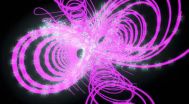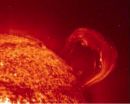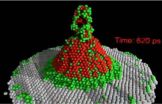Imaging of Alfvén waves and fast ions in a fusion plasma
News from the 52nd annual meeting of the APS Division of Plasma Physics
2010-11-09
(Press-News.org) Fusion plasmas in the laboratory typically reach 100 million degrees. These high temperatures are required to ignite the hydrogen plasma and maintain the fusion burn by the production of high-energy alpha particles. One challenge for a fusion reactor is how to contain the alpha particles in the vessel long enough for the particles to efficiently heat the hydrogen plasma. One way that these alpha particles can escape the fusion chamber prematurely is by exciting high frequency Alfvén waves and riding these waves to the vessel walls, like a surfer rides a wave to the beach.
While it is easy to sit on the seashore and watch surfers riding waves to the beach, it is far more challenging to see the alpha particles riding Alfvén waves to the walls of a fusion reactor. Recently, researchers have provided the first 2-D visualization of the elegant 3-D spiral pattern of these Alfvén waves together with the observation of the energetic particles that ride these waves to the walls of the reactor (Fig. 1). The breakthrough allowing the measurement of these Alfvén waves is the development of a highly sensitive camera designed to measure minute temperature fluctuations inside the plasma that indicate the presence of these Alfvén waves. These results will be presented at the American Physical Society Division of Plasma Physics 52nd annual meeting, November 8, in Chicago, Illinois by researchers from DIII-D National Fusion Facility and the ASDEX Upgrade tokamak.
In the experiments on the DIII-D tokamak, beams of high-energy particles are injected into the plasma to simulate the alpha particles expected in a fusion reactor. These particles then excite Alfvén waves similar to what's expected in a reactor and under the right conditions they can ride these waves to the wall. By studying the behavior of the energetic particles and Alfvén waves, we can learn a great deal about what to expect in a fusion reactor.
Unprecedented images of these Alfvén waves have recently been obtained by recording the variation in the plasma temperature using a special camera. These cameras are basically heat detectors, much like IR cameras used to image thermal objects at night. However the camera developed on DIII-D is optimized for resolving tiny variations in the plasma temperature by measuring the "heat" radiated in the form of microwaves, much like the radiation emitted by a microwave oven.
The images show that the fusion plasma has a torus shape and the plasma waves spiral around the torus. Many features of the theoretical prediction of these waves are observed in the images, such as the location of the waves in the plasma, the wavelength of the wave and the twisting spiral pattern of the wave.
In addition to these remarkable images of the Alfvén waves, new measurements have been obtained of the particles that excite these waves and ride the waves to the walls.
Recently, a technique has been developed to directly measure ions that strike the wall after riding the Alfvén waves out of the plasma. A phosphor screen is used that lights up when struck by these escaping particles and a camera is used to image the phosphor. The pattern of the light on the screen provides specific information on the energy and direction of the particles arriving at the wall. Fast images of the phosphor show bunches of beam particles arriving to the wall synchronized with the arrival of the Alfvén waves. This is similar to watching multiple surfers riding a single wave, where these surfers all arrive at the beach together.
Thanks to the focused effort of a large international collaboration, modeling efforts to simulate these recent experiments are now able to reproduce many of the features of both the Alfvén wave structure and the particle losses. These same codes are presently being used to predict the presence of Alfvén eigenmodes in ITER and initial results show that modes similar to those observed in DIII-D and ASDEX-Upgrade will be present. A key challenge for the future is to find ways of suppressing these Alfvén waves in a fusion reactor or at least minimizing their effect on the alpha particles.
###
This work was supported by the U.S. Department of Energy under DE-AC02-09CH11466 and DE-FC02-04ER54698.
END
ELSE PRESS RELEASES FROM THIS DATE:
2010-11-09
When physicists probe the mysteries of plasma, the fourth state of matter, they often discover phenomena of striking beauty. Much as when the Hubble Space Telescope sent back vivid images from space of ionized gas clouds (an interstellar plasma!), new 3D images of shear Alfvén waves are delighting both scientists and a new generation of science enthusiasts.
Plasmas support a large variety of waves. Some of these are familiar, such as light and sound waves, but a great many exist nowhere else. One of the fundamental waves in magnetized plasma is the shear Alfvén wave, ...
2010-11-09
Just like an electrical switch allows the flow of electricity into electrical circuits, relativistic transparency in plasma can act like a fast optical switch allowing the flow of light through otherwise opaque plasma. Modern day lasers, such as the Trident laser in Los Alamos National Laboratory delivers a 200 terawatt power pulse (roughly 400 times the average electrical consumption of the United States) in half a trillionth of a second (picosecond) time. As shown in Fig. 1, when the laser power reaches a threshold limit, relativistic transparency in plasma turns the ...
2010-11-09
The Sun sporadically expels trillions of tons of million-degree hydrogen gas in explosions called coronal mass ejections (CMEs). Such clouds—an example is shown in Figure 1a—are enormous in size (spanning millions of miles) and are made up of magnetized plasma gases, so hot that hydrogen atoms are ionized. CMEs are rapidly accelerated by magnetic forces to speeds of hundreds of kilometers per second to upwards of 2,000 kilometers per second in several tens of minutes. CMEs are closely related to solar flares and, when they impinge on the Earth, can trigger spectacular auroral ...
2010-11-09
Physicists working on the National Spherical Torus Experiment (NSTX) at the Princeton Plasma Physics Laboratory are now one step closer to solving one of the grand challenges of magnetic fusion research—how to reduce the effect that the hot plasma has on fusion machine walls (or how to tame the plasma-material interface). Some heat from the hot plasma core of a fusion energy device escapes the plasma and can interact with reactor vessel walls. This not only erodes the walls and other components, but also contaminates the plasma—all challenges for practical fusion. One method ...
2010-11-09
Whenever two pieces of metal at different voltages are brought near each other, as when an appliance is plugged into a live socket, there is a chance there will be an arc between them. Most of the arcs people see are a breakdown of the gas between the metal surfaces, but this type of breakdown can also occur in a vacuum. This vacuum breakdown, which until recently has not been well understood, has implications for applications from particle accelerators to fusion reactors.
As part of an effort to understand the maximum accelerating field in particle accelerators, scientists ...
2010-11-09
The outlook for patients with breast cancer is determined in part by whether or not their tumor has spread to other sites in the body. A team of researchers, led by Roman Perez-Fernandez and colleagues, at the University of Santiago de Compostela, Spain, has now identified in a subset of patients with breast cancer, a marker associated with the occurrence of tumors at distant sites; a finding that they hope might help predict a patient's outlook more accurately. Specifically, the team found that in patients with breast cancer that was accompanied by the presence of tumor ...
2010-11-09
EDITOR'S PICK: PIT(-1)ting good and bad outcomes against each other in breast cancer
The outlook for patients with breast cancer is determined in part by whether or not their tumor has spread to other sites in the body. A team of researchers, led by Roman Perez-Fernandez and colleagues, at the University of Santiago de Compostela, Spain, has now identified in a subset of patients with breast cancer, a marker associated with the occurrence of tumors at distant sites; a finding that they hope might help predict a patient's outlook more accurately. Specifically, the team ...
2010-11-09
Females are more likely to have an unprotected first sexual encounter than their male counterparts.
This finding was a surprise to Nicole Weller, an Arizona State University graduate student working toward her doctoral degree in sociology, who presented preliminary findings on research she is conducting on the relationship between early sex education and the onset of sexual activity at the 138th annual American Public Health Association Social Justice Meeting and Expo in Denver on Monday, Nov. 8. Weller is a student in the School of Social and Family Dynamics in the College ...
2010-11-09
Using proton pump inhibitors (PPIs) and antiplatelet drugs (thienopyridines) together is an appropriate way of treating patients with cardiovascular (CV) disease who are at high risk of upper gastrointestinal (GI) bleeds, despite recent concerns about an adverse interaction between these two types of drugs, according to an Expert Consensus Document released jointly today by the American College of Cardiology Foundation (ACCF), the American College of Gastroenterology (ACG), and the American Heart Association (AHA).
The potential benefits of antiplatelet therapy for patients ...
2010-11-09
(SACRAMENTO, Calif.) — Older people who are leading active, healthy lifestyles often have silent vascular disease that can be seen on brain scans that affect their ability to think, according to a new study led by UC Davis researchers and published online today in the Archives of Neurology, one of the JAMA Archives journals.
"This study shows that silent vascular disease is really common as we get older and it influences our thinking abilities," said Charles DeCarli, professor of neurology in the School of Medicine at UC Davis and director of the UC Davis Alzheimer's ...
LAST 30 PRESS RELEASES:
[Press-News.org] Imaging of Alfvén waves and fast ions in a fusion plasma
News from the 52nd annual meeting of the APS Division of Plasma Physics



